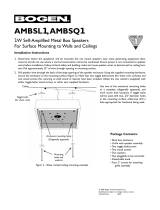Contents
Page
PANEL DESCRIPTIONS..................................................................................................2-3
Power Vector Front Panel..................................................................................................................2
Power Vector Rear Panel ..................................................................................................................3
INSTALLATION ..................................................................................................................4
Package Contents ................................................................................................................................4
Ventilation and Mounting ..................................................................................................................4
Models V250 and V150 ................................................................................................................4
Models V100,V60, and V35 ..........................................................................................................4
Rack Mounting ..............................................................................................................................4
Shelf/Table Mounting ....................................................................................................................4
Module Installation ..............................................................................................................................4
MODULES ............................................................................................................................5
Output Modules ..................................................................................................................................5
Functionality ....................................................................................................................................5
Input Modules ......................................................................................................................................5
Functionality ....................................................................................................................................5
Priorities ..........................................................................................................................................5
CONNECTIONS ..............................................................................................................6-8
Speakers ................................................................................................................................................6
Transformer-Coupled Speaker Connections ................................................................................6
4-Ohm Low-Impedance Speaker Connections............................................................................6
COM and GND Terminals ............................................................................................................7
Remote Volume Control ....................................................................................................................7
Pre-EQ Output ....................................................................................................................................7
Signal-Processing Inserts ....................................................................................................................7
Mute Control........................................................................................................................................8
Bridging ..................................................................................................................................................8
System Expansion of Power Vector Amplifiers ............................................................................8
OPERATION ..................................................................................................................9-10
Front Panel Controls & Indicators ..................................................................................................9
Input Volume Controls....................................................................................................................9
Signal / Clip Indicator ....................................................................................................................9
Base and Treble Controls ..............................................................................................................9
Master Volume Control ..................................................................................................................9
Average / Peak Switch & LED Output Meter ............................................................................9
Power Switch / Power Indicator ....................................................................................................9
Rear Panel Controls ........................................................................................................................10
Load Selector Switch ..................................................................................................................10
Other Controls ................................................................................................................................10
Tone Control Bypass Switch........................................................................................................10
Low-Cut Switch ............................................................................................................................10
BLOCK DIAGRAM ............................................................................................................11
SPECIFICATIONS ............................................................................................................12
TROUBLESHOOTING ....................................................................................................13
WARRANTY ......................................................................................................Back Cover
ACCESSORIES ..................................................................................................Back Cover
1

















